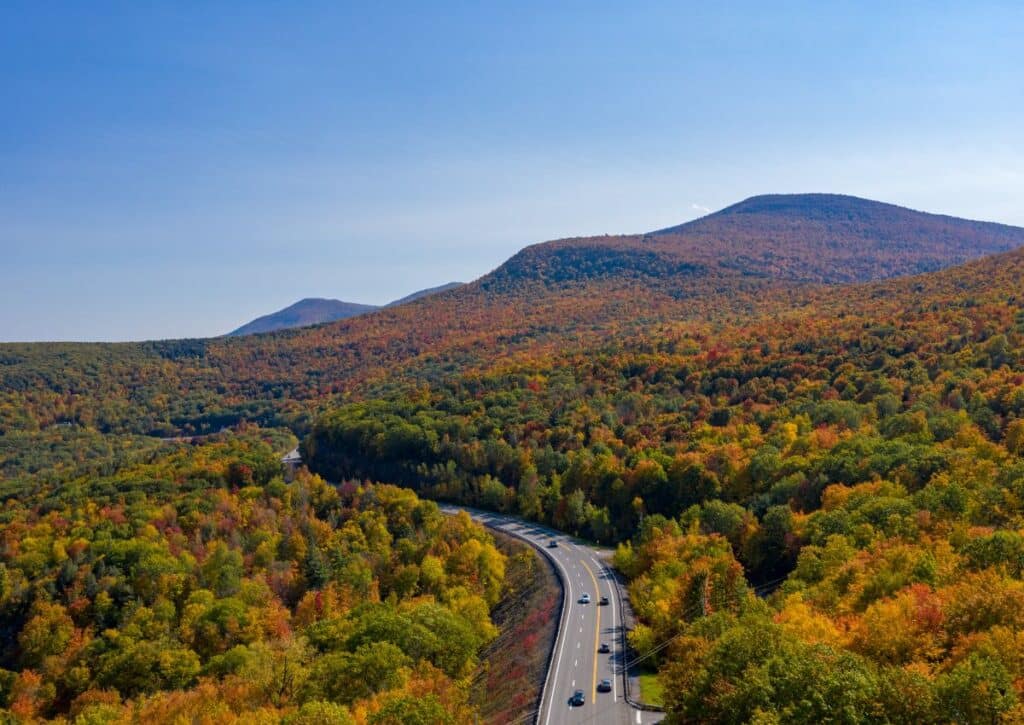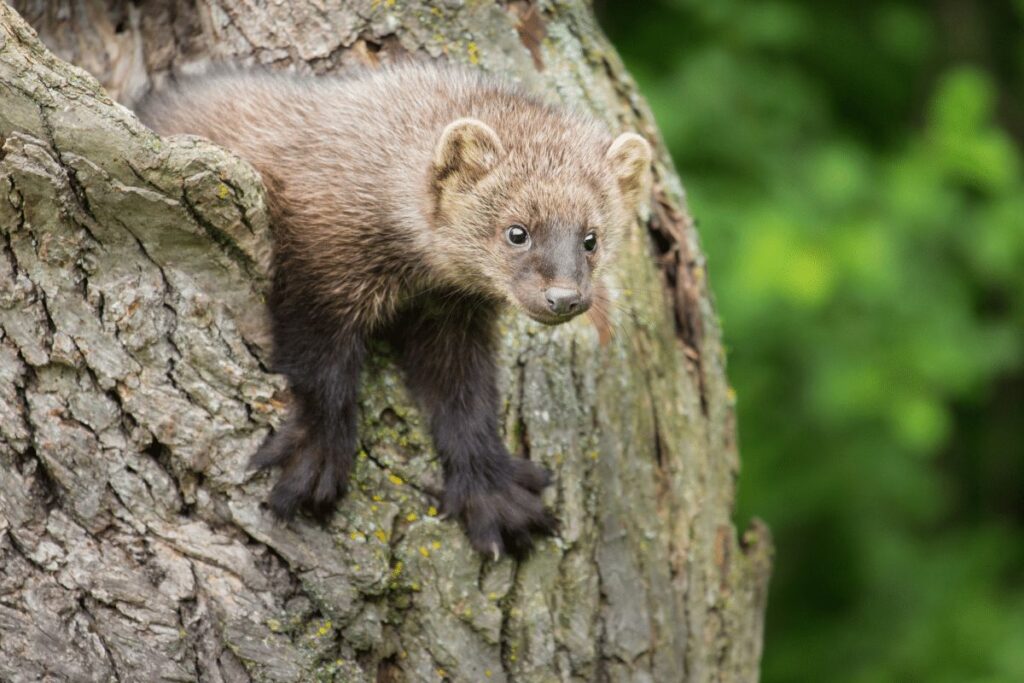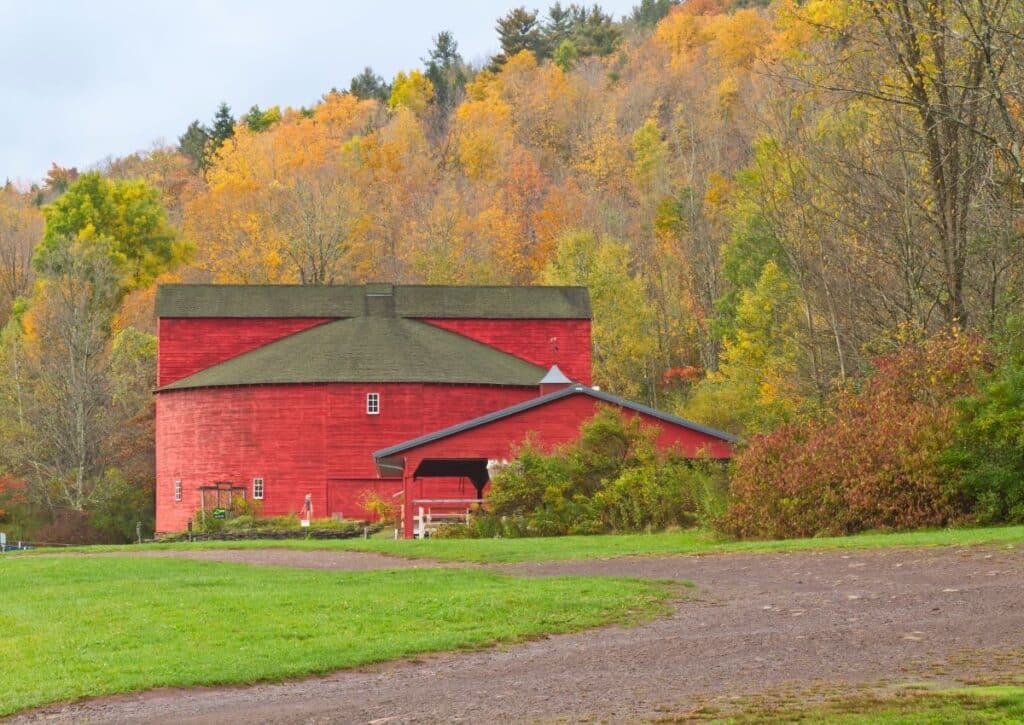Discover the best time to visit the Catskills in our comprehensive guide. From spring blooms to autumn's fiery foliage, find the perfect season for your trip
Ready to embark on a journey to the enchanting Catskills? Finding the ideal time to visit this natural wonderland can be like picking the perfect apple from a tree: every season has its flavor.
Spring welcomes you with melodious birdsong and wildflowers peeping out. Summer promises sun-kissed adventures and pristine lake reflections.
While winter paints a snowy wonderland perfect for cozy retreats, autumn?
Oh, autumn is the Catskills’ show-stopper: a kaleidoscope of fiery foliage that looks like nature’s own fireworks display. Having wandered its trails and hamlets for over two decades, we’re spilling the beans on when you should pack your bags for the most memorable experience.
Whether you’re a leaf-peeper, a snow bunny, or a sunshine lover, we’ve got the scoop on the best time to immerse yourself in the magic of the Catskills! Let’s journey through the seasons together!
A Brief Overview of the Catskills
Geography, Importance, and Diversity:
Nestled in southeastern New York, the Catskills span a staggering 6,000 square miles, with peaks reaching up to 4,180 feet at Slide Mountain.
Far from being a mere extension of the Appalachians, the Catskills were shaped by a unique geological dance involving glaciers and tectonics.
Historically, the region served as a muse for the Hudson River School painters and was a hub during the 19th-century timber and tanning boom.
Today, it’s home to over 20 state forest preserves and hosts more than 400 animal species.
The Right Time Equals the Best Experience:
The Catskills aren’t a one-season wonder. Over 1.5 million annual visitors can attest to its year-round allure, but choosing your timing can tailor your experience.
Dreaming of kayaking? You’d love the summer. Want to spot a bobcat or capture the perfect fall photograph? Timing is crucial.
Dive into the Seasons:
Spring: Waterfalls gush with vigor from melting snow, and by May, over 100 species of migratory birds touch down in the region.
Summer: With average highs of 78°F, it’s a prime time for exploring the 300+ miles of hiking trails or diving into one of the numerous freshwater lakes.
Fall: A vivid canvas of colors comes alive, especially during the third week of October when nearly 80% of trees like maples and oaks showcase their best hues. Plus, the elk population becomes notably active!
Winter: Snowfall averages 40 inches annually, turning the region into a snowy playground with skiing, snowshoeing, and the chance to witness frozen waterfalls.
With the Catskills, the season you choose dictates the adventure that awaits.
Best Time to Visit the Catskills: Season-by-Season Guide
The Catskills offer a captivating mix of dense forests, rolling hills, and vibrant communities. This region has long been a haven for hikers, wildlife enthusiasts, and those seeking a retreat from urban hustle.
But to truly capture its essence, timing is everything. Each season paints the Catskills with a unique brush, unlocking varied experiences.
As you consider a trip to this natural paradise, it’s essential to align your visit with the seasonal offerings, ensuring you experience the Catskills at its peak.
High Season in the Catskills: June through October
The Catskills from June to October is a natural spectacle, a time when this magnificent region unfurls its grandeur, painting a tableau of activities and experiences.
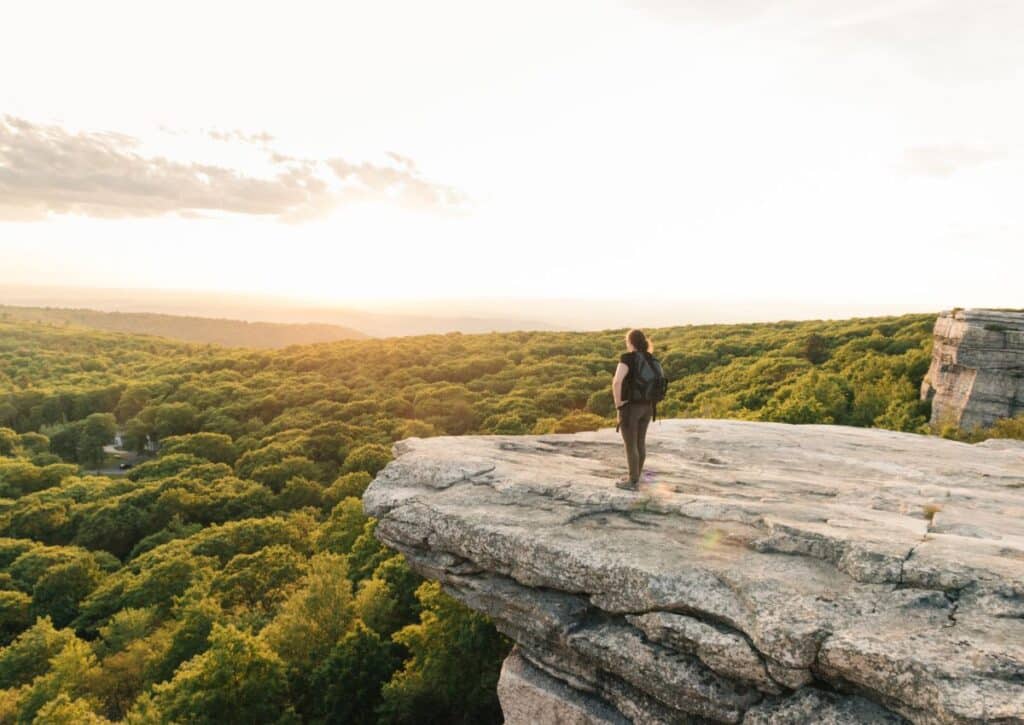
With temperatures hovering between a pleasant 60°F and 80°F, the weather sets the stage for explorations.
As days lengthen and the sun casts a golden hue, evenings often bring a mild chill, hinting at the approaching autumn.
One of the primary attractions is undoubtedly hiking. Traverse the pathways of Slide Mountain, the highest peak in the Catskills, or saunter through the scenic routes of Kaaterskill Falls Trail, leading to a mesmerizing two-tiered waterfall.
Overlook Mountain is another gem, where history intertwines with nature, presenting hikers with ruins of an old hotel and a panoramic view from its famed fire tower.
But the Catskills isn’t just about trails. The waterways, especially the Esopus Creek, call out to the adventurer in you. It’s a playground for those seeking the thrill of white-water rafting or a serene canoeing or kayaking experience.
Anglers find solace here too, with regions like Beaverkill River and Willowemoc Creek teeming with trout. Remember, however, to familiarize yourself with local regulations and secure necessary permits.
During these months, the Catskills Park Services are pivotal in enhancing the visitor experience. Through guided wildlife tours, they provide a unique opportunity to get close to the resident fauna, like black bears and white-tailed deer.
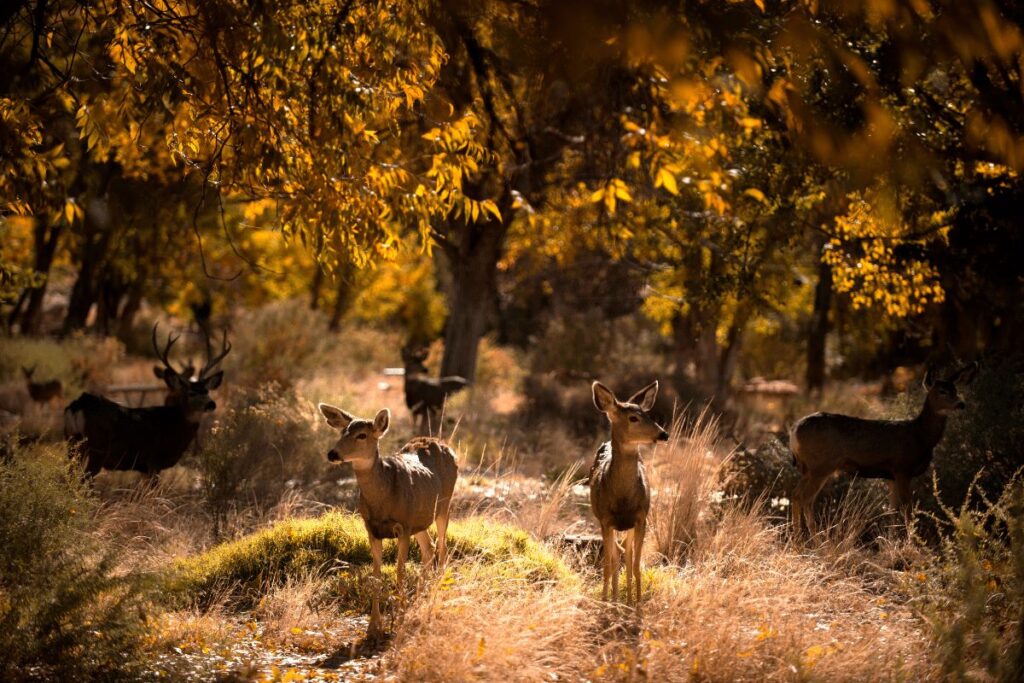
The interpretive nature walks, led by seasoned park rangers, peel back the layers of the region’s ecosystem, offering insights into its flora, geology, and more.
Birdwatchers, too, find this season particularly rewarding, with migratory species making their passage.
For those inclined towards an extended stay under the stars, camping is a must.
Whether you fancy the rustic charm of a tent or the comforts of an RV, venues like North-South Lake Campground and Devil’s Tombstone have got you covered. A little heads-up: the weekends can get busy, so it’s wise to book in advance.
Amidst the backdrop of natural wonders, the region pulses with cultural vibrancy. Festivals dot the calendar, each celebrating a different facet of Catskill life.
Be it the tuneful melodies of the Catskill Mountain Jazz Series or the numerous harvest festivals marking the bounty of apples and pumpkins in September and October, there’s a communal celebration waiting at every corner.
Spring in the Catskills: Rebirth and Blossoming
As winter’s icy grip slowly releases its hold, the Catskills awakens with a vibrancy and energy that promises new beginnings.
Spring’s arrival heralds a time of rebirth, painting the region with a palette of blooming wildflowers, the song of returning birds, and cascading waterfalls energized by melting snow.
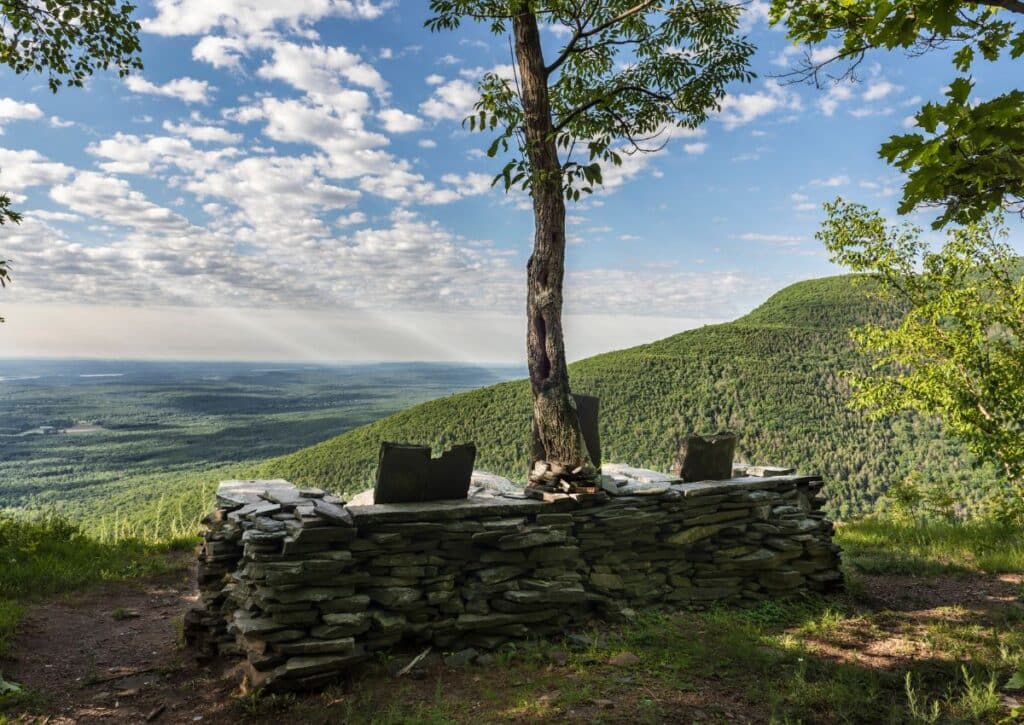
Shoulder Season Advantage (April & May):
For the savvy traveler, the shoulder months of April and May offer an unparalleled advantage.
With the high tourist season yet to kick in, accommodations in towns like Woodstock, Phoenicia, and Tannersville frequently offer reduced rates, making it a golden period for budget-conscious visitors.
Moreover, local businesses often roll out special deals and packages, aiming to attract early visitors.
April Fishing Fever:
As April’s warmth starts to melt away winter’s remnants, it also signals the onset of fishing season. Streams and rivers, like the renowned Beaverkill River and Willowemoc Creek, come alive with brown, brook, and rainbow trout.

Anglers from all corners make their way to these pristine water bodies, eager to cast their lines and relish the thrill of the catch.
Remember, as always, to check for local fishing regulations and acquire the necessary permits.
Birdwatching in May:
May is a treat for ornithologists and bird lovers alike. The Catskills becomes a bustling hub for migratory birds, each species bringing its own melody.
The forests and wetlands near Balsam Lake or the meadows of Roxbury are prime spots for birdwatching.
Here, one can hope to spot the vibrant Scarlet Tanager, melodious Warblers, and the striking Baltimore Oriole, among others.
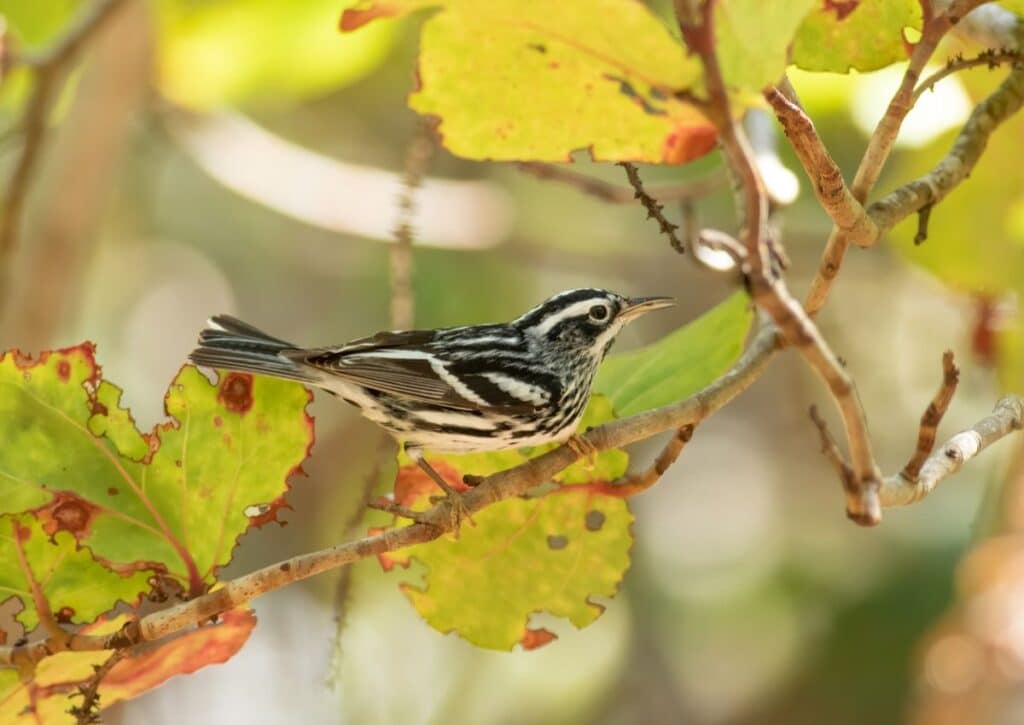
Whether you’re a seasoned birdwatcher or a novice, the experience is sure to be mesmerizing.
Plant Life:
Spring is when the Catskills truly dress up. Wildflowers blanket the ground, offering a colorful contrast to the green lushness of the valleys.
Whether you’re driving through the scenic Route 28 or strolling through areas like Platte Clove, you’ll be met with bursts of color from blossoms like Trillium, Lady’s Slipper Orchids, and Jack-in-the-Pulpit.
Their fragrance and visual appeal add a touch of magic to the landscape.
Hiking:
Spring, with its moderate temperatures, is an inviting season for hikers. The melting snow feeds the region’s waterfalls, making them a sight to behold.
Trails leading to Kaaterskill Falls or Vernooy Kill Falls promise not just an invigorating hike but also a majestic view of cascades at their peak.
But a word of caution: spring trails can be muddy and a bit slippery. It’s vital to wear proper hiking shoes, check trail conditions before heading out, and be prepared for changing weather.
Special Events:
The enthusiasm of spring doesn’t just resonate in nature but spills over to the towns and communities of the Catskills.
Local festivals celebrating the season’s bounty, arts, and crafts fairs, and spring-specific activities become the order of the day.
The Wild Ramp Festival in Phoenicia celebrates the wild leek harvest, while places like Woodstock host garden tours, showcasing beautifully curated private gardens in their springtime splendor.
Summer in the Catskills: Prime Time for Adventure
The Catskills, with its verdant forests, meandering rivers, and charming towns, transforms into an adventurer’s paradise come summer.
The sun-kissed days and balmy evenings set the stage for an array of activities, catering to thrill-seekers and nature lovers alike.
Wildlife Watching:
Summer’s warmth sees the Catskills brimming with life. The dense forests, like those near Hunter and Windham, play host to a diverse range of mammals.
White-tailed deer, often spotted near Slide Mountain, graze the meadows, while black bears, a more elusive sight, roam the woods.
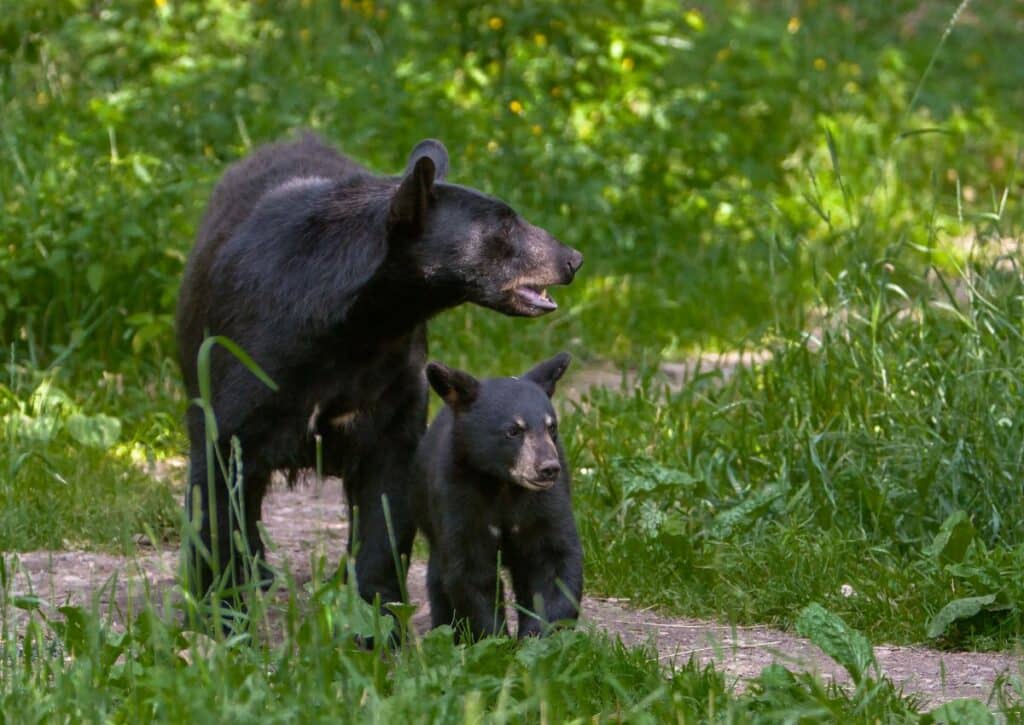
Birdwatchers can revel in spotting species such as the Red-tailed Hawk, Indigo Buntings, and the ever-elusive Wood Thrush.
As the sun sets, the symphony of insects, particularly near wetlands in places like Balsam Lake, fills the air, adding another layer to the region’s vibrant ecosystem.
Hiking:
Hiking in the Catskills during summer is an experience unto itself. The trails, now free from winter’s snow and spring’s mud, beckon adventurers. Giant Ledge and Panther Mountain Trail offer breathtaking views, making the climb worth every effort.
The Escarpment Trail, meandering through a series of peaks, presents a challenging yet rewarding experience, with vistas that stretch as far as Massachusetts on clear days.
Summer hiking also offers the advantage of extended daylight, giving enthusiasts ample time to explore. However, it’s essential to stay hydrated, wear sun protection, and be wary of ticks during these months.
Camping:
What better way to truly immerse oneself in the Catskills than camping under the stars?
Mongaup Pond Campground, nestled amidst a dense forest and alongside the largest body of fresh water in the Catskills, offers a pristine experience. For those who prefer more elevated terrains, the Devil’s Tombstone Campground is an excellent choice.
Due to summer being the peak season, securing a camping spot can be competitive. It’s advisable to reserve spots early, especially for popular sites.
And while the summer days are warm, nights can get cool, so packing a comfortable sleeping bag and a warm jacket is essential.
Water Activities:
The Catskills’ waterways come alive in the summer. Rivers like the Esopus Creek and Delaware River offer excellent opportunities for white-water rafting and kayaking.
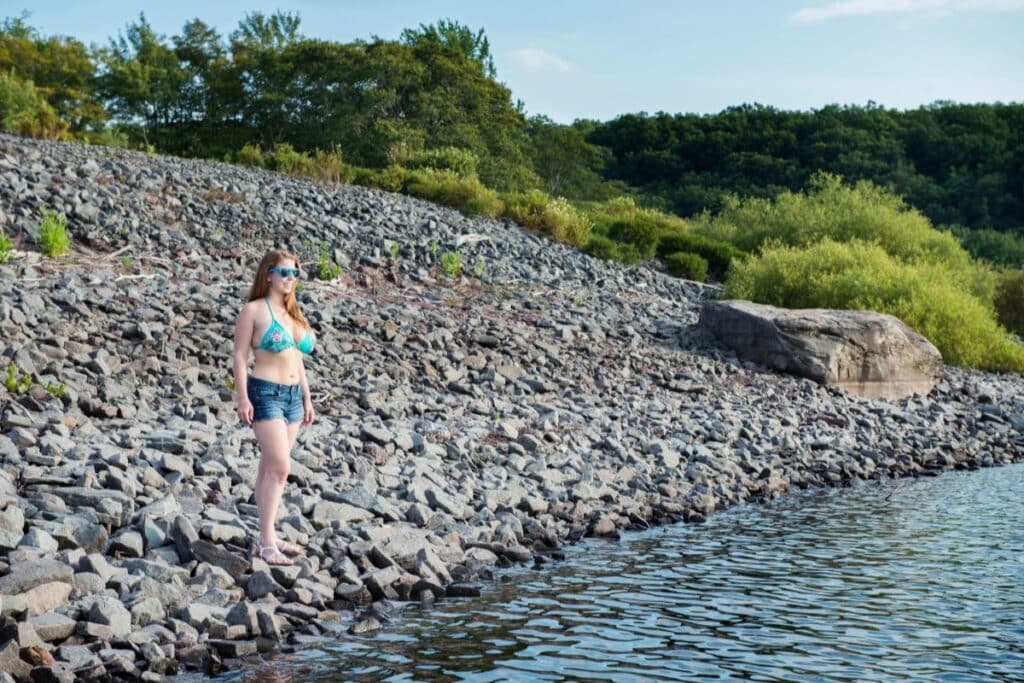
For a more relaxed pace, canoeing on the Ashokan Reservoir is an ideal choice, providing a chance to soak in the picturesque surroundings.
And for anglers, summer is prime time. Whether fly fishing in the Beaverkill River or bait fishing in the many streams, the region promises a rich haul, including the famed Catskill trout.
Special Events:
The spirit of summer is not just confined to the trails and rivers but resonates through the Catskills’ towns and communities.
Woodstock, with its rich musical heritage, often hosts outdoor concerts, drawing crowds from far and wide.
The Catskill Mountain Jazz Series in Delhi is a treat for music lovers.
In Andes, the community comes together for the Andes Community Days, celebrating the town’s heritage and culture with parades, music, and local cuisine. And no Catskills summer is complete without the numerous farmers’ markets.
Towns like Saugerties and Roxbury host these, providing a platform for local artisans and farmers to showcase their produce and crafts.
Autumn in the Catskills: The Symphony of Colors
When autumn graces the Catskills, it paints the region in a breathtaking palette of reds, oranges, and golds.
This period, stretching from the end of summer till winter’s first whisper, is a symphony of colors and experiences that resonates deeply with anyone lucky enough to witness it.
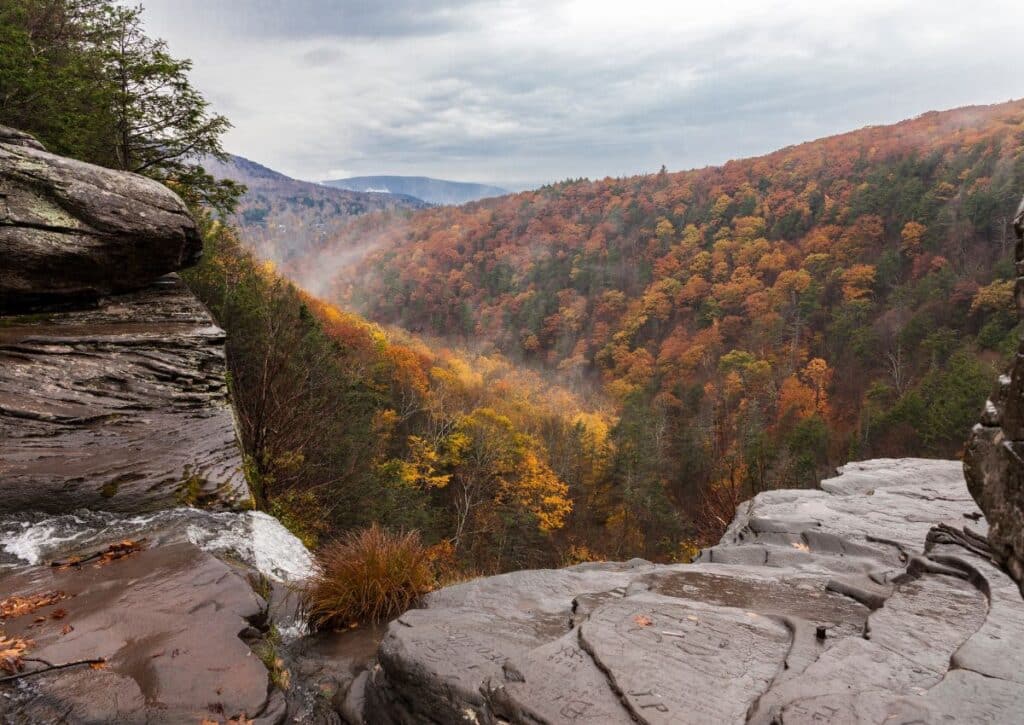
September’s Apple Bounty:
As September rolls in, the orchards of the Catskills burst into activity. The apple trees, laden with ripe fruits, invite visitors to indulge in the age-old tradition of apple picking.
Masker Orchards in Warwick allows families to drive right up to the trees, making it an accessible and fun-filled outing.
Stone Ridge Orchard in Stone Ridge, with its variety of heritage apples, offers both picking and tasting events.
Beyond just picking, many orchards, like Wright’s Farm in Gardiner, expand the experience with hayrides, petting zoos, and cider tastings.
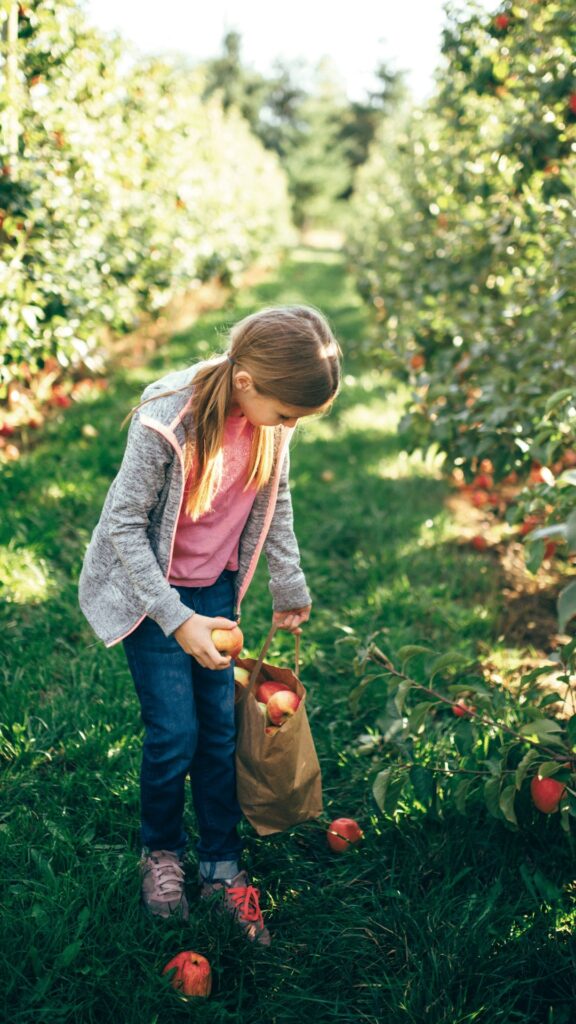
The crisp air filled with the scent of fresh apples epitomizes the beginning of the Catskill’s autumn season.
October’s Grandeur:
October sees the Catskills draped in a mesmerizing array of colors. The region becomes a magnet for “leaf peepers,” enthusiasts who travel just to experience this natural spectacle.
The Overlook Mountain Trail near Woodstock provides panoramic views of the sea of changing colors. A drive along the Catskill Mountain Scenic Byway is equally enchanting, with every turn revealing a canvas painted by nature.
North-South Lake in Haines Falls and Kaaterskill Falls, the state’s highest cascading waterfall, gain an added layer of beauty with the backdrop of autumn colors.
When planning a trip, it’s wise to keep track of foliage reports, as the peak colors change swiftly and vary across elevations.
Wildlife Activities:
Autumn also signals a time of change for the Catskills’ wildlife. Animals start preparing for the cold months ahead.
Squirrels can be seen busily gathering acorns in areas like Bear Spring Mountain Wildlife Management Area, while deer increase their feeding—often seen grazing in clearings during twilight hours.
This is also a significant time for birdwatchers, as several species, like the Canada geese, begin their migration south, turning the skies into a dynamic display.
Hunting in November:
With the rustle of fallen leaves underfoot, November inaugurates the hunting season in the Catskills.
The region, rich in game like deer, turkey, and bear, attracts hunters from all over. Areas such as the Sundown Wild Forest and the Willowemoc Wild Forest are popular hunting grounds. However, hunting in the Catskills is regulated to ensure sustainable practices and the safety of all visitors.
Familiarity with New York’s hunting regulations, seasons, and necessary permits is essential before embarking on a hunting expedition.
Special Events:
The essence of autumn in the Catskills is not just in its landscapes but also in its vibrant community celebrations.
Towns like Hobart, dubbed the “Book Village of the Catskills”, host the Hobart Fall Festival – a delightful blend of book sales, local food, and live music.
Tannersville’s Crazy Race & Festival is another highlight, celebrating the end of the season with races, craft vendors, and a vibrant parade.
For those intrigued by the supernatural, the Phoenicia Mystery Weekend in November offers a fun-filled detective experience combined with the charm of a small-town gathering.
Winter in the Catskills: The Quiet Allure
There’s an indescribable charm that envelopes the Catskills during winter. The bustle of the earlier seasons gives way to a profound quietness, only broken occasionally by the crunch of snow underfoot.
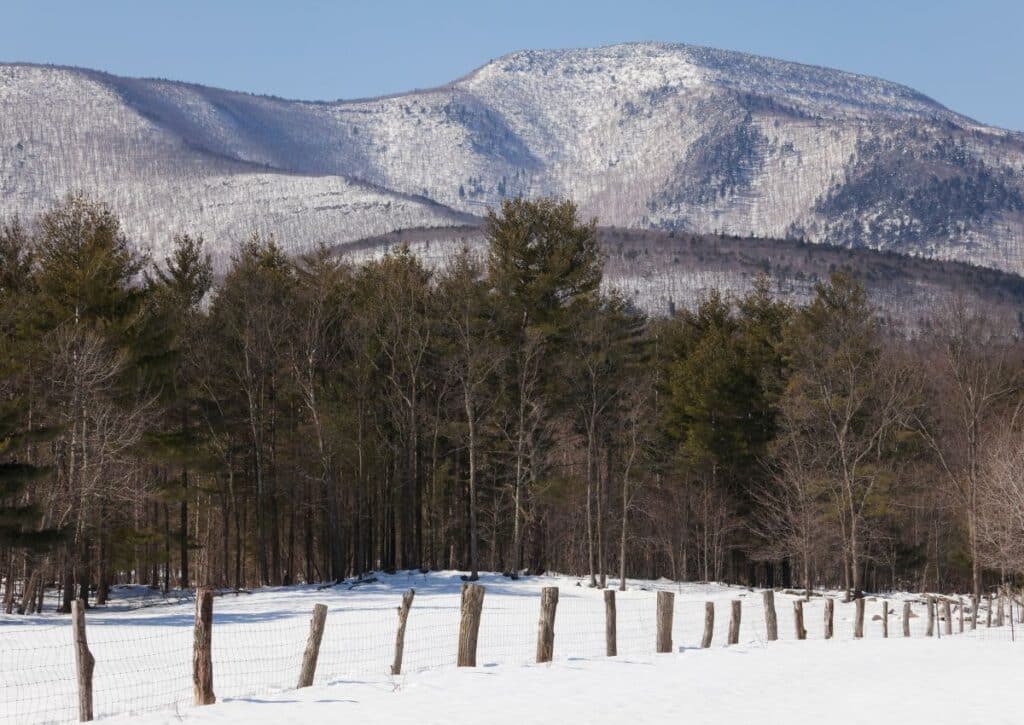
The mountainous canvas, once rich with colors, is now painted in shades of white and blue, exuding a serene allure.
The Serenity of January:
January in the Catskills is an ode to the snow. The region transforms into a paradise for winter sports enthusiasts.
Belleayre Mountain in Highmount and Hunter Mountain in Hunter are popular spots for skiing and snowboarding, boasting a range of slopes to cater to both novices and experts.
For those looking for a slower pace, Windham Mountain offers scenic snowshoeing trails, providing a unique perspective of the Catskills’ beauty.
The towns of Phoenicia and Fleischmanns are great launch points for these activities, with local stores offering equipment rentals and guided tours.
February’s Icy Adventures:
As February settles in, the ice strengthens its grip on the Catskills. This month is perfect for those looking to experience the thrill of ice fishing, with the frozen surfaces of North-South Lake and Cooper Lake teeming with trout and bass.
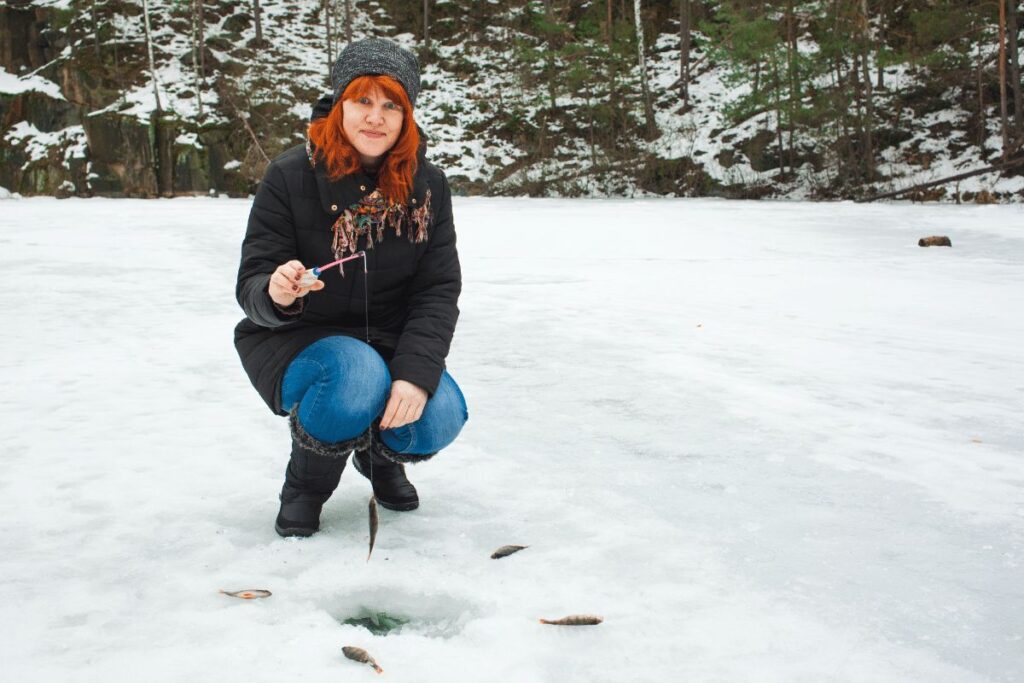
Additionally, Kaaterskill Falls transforms into an ethereal cascade of ice, making it a hotspot for ice climbing, albeit for the more experienced.
For those who’d prefer to marvel at nature’s icy sculptures from a distance, a visit to Fawn’s Leap presents the opportunity to see ice climbers in action.
Muddy March:
March is a transition month. As winter begins to loosen its hold, the melting snow turns trails and paths muddy.
While this can present challenges for traditional hiking, it’s an ideal time for mountain biking, especially on trails like Jockey Hill in Kingston or Elm Ridge in Windham.
Waterproof footwear and gaiters are recommended for those who venture out during this period.
March also heralds the onset of maple tapping, and a visit to places like Catskill Mountain Sugar House in Grahamsville offers insights into the fascinating process of turning sap into syrup.
Winter Wildlife in the Catskills:
Even in the chill of winter, the Catskills resonate with the subtle rhythms of nature. Each area offers a unique encounter.
In places like Slide Mountain Wilderness and Indian Head Mountain, deer tread softly, leaving behind their fleeting footprints on the snow.
The dense woodlands of Colgate Lake Wild Forest might offer a rare sight of a mink or a fisher darting through the underbrush.
The frozen banks of Ashokan Reservoir often reveal traces of river otters sliding into the icy waters, while the thicketed areas near Vernooy Kill Falls are a playground for snowshoe hares.
Amid the bare trees, birdwatchers are in for a treat as well. Aside from the regal Snowy Owl, the golden-crowned kinglet and crossbills often make an appearance, flitting between trees in places like Giant Ledge and Big Indian Wilderness.
These regions, shrouded in winter’s stillness, come alive with muted calls, rustling leaves, and fleeting shadows, revealing the enduring vitality of the Catskills’ diverse fauna.
Special Events:
Despite the cold, the Catskills’ spirit remains undeterred, with numerous winter events lighting up the season.
Woodstock’s WinterFest celebrates the season with ice sculptures, horse-drawn sleigh rides, and local crafts.
The Lights in the Park event in Tannersville is a sight to behold, as the town park transforms into a twinkling wonderland.
For those keen on cultural experiences, the Hanford Mills Ice Harvest Festival in East Meredith offers a nostalgic trip back in time, showcasing how ice was harvested before refrigeration.
Weather in the Catskills
The Catskills, characterized by its sprawling mountains, dense forests, and meandering rivers, experience a range of weather patterns that mold its ever-changing landscape.
Whether it’s the gentle touch of spring rain or the piercing cold of a winter storm, the region’s weather plays a pivotal role in shaping both its natural splendor and the outdoor adventures it offers.
The Spring Thaw: Come spring, the Catskills gradually emerge from the winter’s embrace.
The months of March and April often witness fluctuating temperatures, which can range anywhere from a chilly 30°F (-1°C) during the early mornings to a more moderate 60°F (15°C) by the afternoon.
It’s a time of rebirth, as melting snow from the higher elevations feeds into streams like the Esopus Creek and the Beaver Kill, making them swell and roar.
Rainfall is frequent but sporadic, with May being the wettest month, rejuvenating the land and setting the stage for a vibrant summer.
Sunny Summers: Summer in the Catskills is a blend of warmth and resplendent beauty. The days, which can peak around 80°F (27°C), are balanced out by cooler nights, often settling around 50°F (10°C).
This temperature range is perfect for exploring places like the Sundown Wild Forest or venturing on a multi-day hike along the Devil’s Path.
While rain showers are not uncommon in the early summer, they’re usually brief, offering a refreshing respite from the day’s heat.
Autumn’s Crispness: Autumn announces its arrival with a spectacle of colors and a distinctive crispness in the air.
September usually enjoys an extension of the summer warmth, with temperatures lingering in the 70s°F (21-26°C).
But as October rolls in, one can expect the mercury to dip, with averages hovering between 40°F (4°C) to 60°F (15°C).
The vibrant foliage of areas like Hunter Mountain and the Phoenicia Wild Forest reaches its peak during this time, with the cooler temperatures enhancing the experience of a quiet walk or a challenging hike.
Winter’s Chill: Winter transforms the Catskills into a snow-laden wonderland.
From December through February, temperatures can plummet, sometimes reaching a frigid 10°F (-12°C) or even lower during particularly cold snaps.
The higher altitudes, especially areas around Slide Mountain and Blackhead Range, can receive substantial snowfall, often exceeding 40 inches in a season.
This cold blanket turns the region into a hub for winter sports, even as many of the water bodies, like North-South Lake, freeze over, mirroring the stark beauty of the skies above.
Final Thoughts: The Catskills Through the Seasons
The Catskills boasts a unique charm every season. From spring’s rebirth, summer’s adventures, and autumn’s colorful tapestry, to winter’s serene beauty, there’s always a reason to visit.
Timing is Crucial: Align your visit with the activities you love most. Whether it’s leaf-peeping in October, skiing in January, fishing in April, or hiking in July, timing can enhance your experience manifold.
Prepare for Weather Shifts: Given the region’s diverse landscape and altitude differences, weather can vary greatly.
Always check local forecasts and come equipped for sudden changes, especially if venturing into higher elevations.
Discover Off-the-Beaten Paths: While renowned trails and spots like Slide Mountain or Hunter Mountain are a must-visit, the Catskills is dotted with lesser-known gems waiting to be explored.
Participate in Local Events: The region hosts a plethora of events, festivals, and gatherings all year round. Engaging with these can offer a deeper connection to the Catskills’ vibrant culture and traditions.
Conservation is Key: The Catskills remains a pristine haven largely due to conservation efforts. As visitors, it’s our responsibility to tread lightly, respect local guidelines, and leave no trace.
By understanding the region’s nuances and respecting its natural beauty, the Catskills promises an unforgettable experience every time.
Whether you’re a first-time visitor or a seasoned traveler, the region beckons with new adventures and memories waiting to be made.

